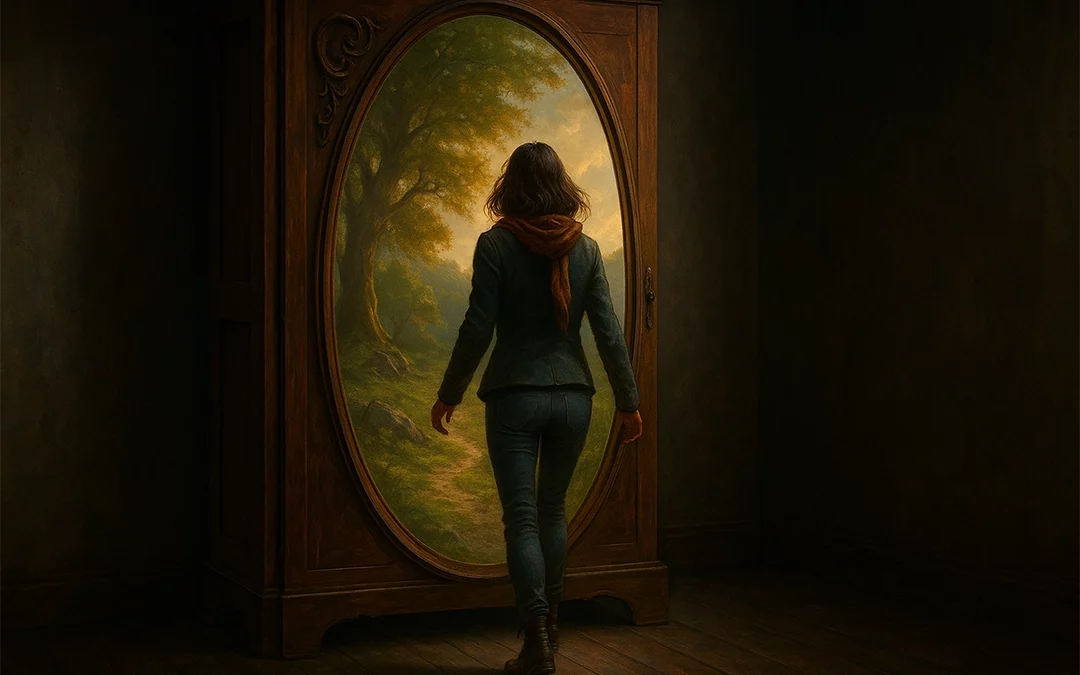We’re drawn to portal-quest fantasy because it lets us slip the skin of ordinary life and go adventuring somewhere marvelous.
The promise is simple and irresistible: there’s more than this, somewhere beyond the wardrobe, behind the brick wall, under the manhole cover, waiting to be discovered.
That tug toward elsewhere powers the subgenre and explains why readers keep returning to it, even when we know the trick.
What is a Portal-Quest Fantasy Story?
At heart, a portal-quest begins with two worlds and a threshold. Someone from here crosses to there—through a wardrobe, a rabbit hole, a hidden platform—and learns the new world’s rules as we do.
The “quest” part arrives quickly: once through, there’s a purpose beyond sightseeing. Find the wizard. Break the curse. Get home changed.
Critic Farah Mendlesohn’s Rhetorics of Fantasy is useful here. She describes portal-quest as a rhetorical mode where discovery is the point: the protagonist is naïve about the other world, so the narrative leans into wonder, orientation, explanation.
Contrast that with immersive fantasies (we’re already “inside” the secondary world and no one explains much), intrusion fantasies (the strange barges into our reality), and liminal fantasies (the strange hums at the edges of the everyday, barely acknowledged). Portal-quest is the mode built for crossing and learning.
A Short History of Stepping Through
The modern template takes shape in the 19th and early 20th centuries.
- Alice tumbles down the rabbit hole and meets a world that rearranges logic and selfhood; the point isn’t slaying a dragon but figuring out who she is in a place that refuses to sit still.
- Dorothy, lifted from Kansas to Oz, follows a yellow road with friends who literalise human longings—brains, heart, courage—and finds a way back with a clearer sense of home.
- Mid-century, the Pevensies push past fur coats into snowlight and lamplight and discover Narnia, a land that lets children rule and then asks them to return wiser, carrying something invisible.
Epic, fully immersive worlds soon dominate adult fantasy, yet the two-world doorway never closes.
Children’s literature keeps it alive through books like The Phantom Tollbooth, while later writers bring the form back into adult fiction with irony, grit, and social bite. The shape shifts, the urge persists.
Why the Threshold Matters
Escapism is only the first layer. The crossing functions as a rite of passage: the protagonist leaves a frame where identity feels fixed and steps into a space where everything must be relearned—language, power, maps, even gravity. That makes the form unusually good at stories of growth. It also gives world-building a narrative justification.
Because the hero is new to the place, explanations arrive as lived experience rather than lecture; we learn the currency of wonder and consequence at the same pace.
Stefan Ekman’s work on fantasy spaces helps explain why these crossings feel charged. Portals are liminal structures—doors, walls, bridges—that encode themes.
A descent (rabbit holes, subways, service tunnels) often hints at the underworld or the city’s subconscious. A stone circle or skyward passage tilts toward myth and transcendence.
Even a front-matter map behaves like a tiny portal, inviting us to step from our world into the book’s before a single line of dialogue. Boundaries aren’t just scenery; they’re meaning.
Classics That Keep Teaching the Form
Return to Alice, Oz, and Narnia and you see how much they established.
Each stakes out a different tone—nonsense and self-interrogation; American fairy tale with a road-trip spine; children’s high adventure braided with moral seriousness—yet all three balance delight with a sober reckoning at the end.
The coming home matters. “There’s no place like home” is less a comfort blanket than a recognition: after elsewhere, home isn’t the same place.
Contemporary Fantasy Doors: Reinvention Without Abandonment
Contemporary fantasy portal-quest often keeps the skeleton and changes the muscle.
In Neil Gaiman’s Neverwhere, London’s portal isn’t a wardrobe; it’s the city’s own cracks. Richard Mayhew falls out of London Above and into London Below, a mosaic of lost spaces and forgotten people where markets float, angels take meetings, and brutality sits next to beauty. The crossing is less a wish than a consequence. The quest—helping Door, surviving assassins, learning to read the city—doubles as a lesson in attention and empathy. The portal becomes social critique: who do we stop seeing, and what does that blindness cost?
In China Miéville’s Un Lun Dun, two schoolgirls slip into an abcity built from London’s discarded things. The book sets up the most entrenched portal trope—the Chosen One—and then breaks it on purpose. The “sidekick” takes over, prophecies prove partial, and cleverness matters more than destiny. It’s affectionate toward the form yet skeptical of its lazier habits. The villain—a sentient Smog—pushes the adventure toward environmental fable without turning the book into homework.
Other works take their own angles. Lev Grossman’s The Magicians wonders what happens when portal wish-fulfillment collides with adult disappointment. Seanan McGuire’s Every Heart a Doorway asks what returning does to a person who tasted a world that finally fit.
Gaiman’s Coraline flips the portal into a trap and makes courage the only key.
Harry Potter bends the idea into a hidden-world structure: Platform 9¾ isn’t another universe, but it scratches the same itch of slipping through the ordinary into a parallel everyday.
None of these discard the core pleasure. They complicate it. The first footstep on the other side still lands with a thump in the chest.
Reader’s Shelf: Where to Start or Revisit
Warm-up classics
- Alice’s Adventures in Wonderland (Carroll)
- The Wonderful Wizard of Oz (Baum)
- The Lion, the Witch and the Wardrobe (Lewis)
Modern with teeth
- Neverwhere (Gaiman) – urban, eerie, compassionate
- Un Lun Dun (Miéville) – inventive, trope-savvy, eco-aware
- Every Heart a Doorway (McGuire) – lyrical, poignant, sharp
- The Magicians (Grossman) – wish fulfillment interrogated
- Coraline (Gaiman) – courage tested on the wrong side of the door
How Portal-Quest Thinks
Three currents keep showing up:
- Escape that reflects. The elsewhere refracts the here. Oz throws home into relief; London Below exposes what London Above refuses to face; UnLondon literalises waste. The trip out is also a look back.
- Discovery as structure. The journey is a tour not of sights but of rules: how power works here, what bargains cost, which old assumptions fail. Mendlesohn’s observation about the naïve traveler explains the delight of good exposition—it’s not filler; it’s plot.
- Return as choice. Going home, staying, or finding a third option becomes the moral hinge. That decision tells us what the adventure meant.
So Why Do We Keep Opening the Door?
Because the form promises an adventure and delivers a reckoning. It lets us run toward wonder and then asks what we’re bringing back. In a noisy age, it also restores a slow, attentive way of seeing: notice the wall, find the gap, step through, learn the rules, pay the price, make the choice.
If you’re picking a starting point, reread Narnia to remember the archetype, then walk the tunnels of Neverwhere and the alleyways of Un Lun Dun to see how the trope carries weight in modern streets. Follow with Every Heart a Doorway for a quiet, aching coda. Different doors; same human hunger.
Next time an ordinary space feels a shade too quiet—a wardrobe, a service stairwell, a blocked-off platform—linger. The great portal stories don’t promise that elsewhere is safer or kinder. They promise that crossing will change how you read the world you return to. That’s the real magic.

D.P. Martinez is a contemporary fantasy author specialising in urban fantasy and magical realism. He holds an M.A. in English Literature from the University of Greenwich, where he focused on Literary London. His research explored metaphorical representations of London in urban fantasy. He has written hundreds of articles and several books across both fiction and non-fiction.

